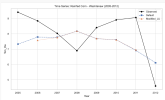Dear Scientists,
I am currently working on a regional case study focused on simulating crop yields and projecting their future trends in Lower Michigan. The configuration I’m using is:
I have a few uncertainties and would appreciate your guidance:
./xmlchange RUN_STARTDATE=0001-01-01
./xmlchange DATM_YR_ALIGN=1
./xmlchange DATM_YR_END=1980
./xmlchange DATM_YR_START=1980
and run the case from 1980 till 2022 and then use the finidate for the actual run. (1980-2022).
I truly appreciate your support and guidance in advance.
Warm regards,
MUR
I am currently working on a regional case study focused on simulating crop yields and projecting their future trends in Lower Michigan. The configuration I’m using is:
- CTSM Version: alpha-ctsm5.2.mksrf.23_ctsm5.1.dev171
- Resolution: 0.05° over Lower Michigan
- Compset: IHISTCLM50_BGC_Crop
- Meterological Forcing: CONUS404
I have a few uncertainties and would appreciate your guidance:
- Do you think incorporating Cropscape data will improve yield results, particularly for the above crop types? Given its higher resolution, I am hopeful it will offer better spatial representation—but I’m interested in your experience or opinion. Potentially, what other data could we replace so it will improve?
- Regarding implementation, I’ve come across two approaches in various threads:
- The first is to modify the raw land cover files and use mksurfdata_map to regenerate the surface dataset after that. I find this complex.
- The second, which I’m considering, is to generate the surface and dynamic land use time series files for the period 1980–2022 (Already Generated), and then modify the crop fractions within the dynamic land use time series using Cropscape data.
- Which approach would you recommend? Are there any specific threads, papers, or resources you suggest I review?
- Based on your experience, what are the most critical factors I should pay close attention to when working on such a case? I’d be grateful for any tips or lessons learned you can share.
- Which kind of spinup do you recommend. I am considering to do spinp as follows:
./xmlchange RUN_STARTDATE=0001-01-01
./xmlchange DATM_YR_ALIGN=1
./xmlchange DATM_YR_END=1980
./xmlchange DATM_YR_START=1980
and run the case from 1980 till 2022 and then use the finidate for the actual run. (1980-2022).
I truly appreciate your support and guidance in advance.
Warm regards,
MUR

